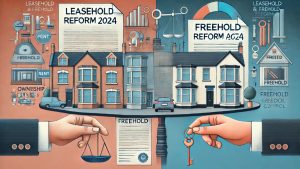The Leasehold and Freehold Reform Act 2024 is set to revolutionize the UK property market, especially for leaseholders. This new legislation addresses many long-standing issues, such as the complex and expensive process of extending leases and purchasing freeholds.
Introduced to modernize the outdated leasehold system, the Act also enforces transparency and fairness for leaseholders and freeholders alike.
By simplifying legal processes and abolishing outdated practices like the marriage value, the Act offers significant financial relief and empowers property owners with more control over their assets. Let’s dive into the key reforms of this landmark legislation.
What is the Leasehold and Freehold Reform Act 2024?

The Leasehold and Freehold Reform Act 2024 was passed into law in May 2024 to strengthen leaseholders’ rights and reduce the burdens associated with property ownership. The primary aim of the Act is to overhaul the leasehold system, ensuring that homeowners, particularly those with long leases, are better protected.
This legislation represents the UK government’s response to growing concerns about the inequitable nature of leasehold agreements, where many leaseholders felt trapped by costly extensions, high service charges, and other financial obligations.
Some of the most significant changes include the simplification of the lease extension process, the removal of marriage value costs, and the introduction of stricter rules governing ground rent and service charges. These changes make the process more affordable and accessible, benefiting both leaseholders and property investors.
What Are the Key Provisions of the Leasehold and Freehold Reform Act 2024?

The Leasehold and Freehold Reform Act 2024 (LAFRA) represents a significant shift in leasehold property law, enhancing rights for leaseholders across England and Wales.
Below is a more detailed breakdown of its key provisions, addressing both leasehold and freehold reforms:
1. Extended Lease Terms (990 Years)
One of the central reforms in the LAFRA is the extension of standard lease terms to 990 years for both houses and flats. This marks a substantial increase from the prior limits of 90 years for flats and 50 years for houses.
Notably, house leaseholders will benefit from peppercorn rents (a token or nominal rent) for lease extensions, bringing these extensions in line with existing rules for flats. This change will effectively eliminate the need for leaseholders to face frequent, costly lease renewals, providing long-term security for leaseholders and enhancing property values.
2. Ban on Leasehold Tenure for New Houses
The act introduces a ban on leasehold tenure for newly built houses, with limited exceptions. This measure reflects increasing dissatisfaction with the practice of selling houses under leasehold arrangements, which often left homeowners subject to escalating ground rents and restrictive terms.
Going forward, most newly built houses will be sold as freehold, allowing buyers full ownership of both the property and the land it stands on.
3. Immediate Lease Extension or Freehold Purchase
Under previous legislation, leaseholders had to wait at least two years before extending their lease or purchasing their property’s freehold.
The 2024 reform removes this waiting period, allowing leaseholders to extend their lease or buy the freehold immediately upon acquiring the property. This change significantly improves flexibility and removes one of the financial burdens associated with buying leasehold property.
4. Abolition of Marriage Value
Another key reform is the abolition of marriage value from the cost calculation for leasehold enfranchisement. Marriage value is the increase in the value of the property that comes from uniting the leaseholder’s and freeholder’s interests.
This value was often a significant factor in determining the cost of extending a lease or buying a freehold, leading to inflated costs for leaseholders. By removing this factor, LAFRA makes the process of enfranchisement (purchasing a freehold or extending a lease) considerably cheaper and fairer.
5. Increased Non-Residential Floorspace for Mixed-Use Buildings
The act increases the allowable non-residential floorspace in mixed-use buildings from 25% to 50% before residential tenants can collectively buy the freehold or take over management.
This change is especially relevant for urban areas where mixed-use buildings, combining residential and commercial spaces, are more common. By raising the threshold, more leaseholders in these buildings will benefit from enfranchisement rights.
6. Tenant Protections for Service Charges
LAFRA strengthens tenant protections under the Landlord and Tenant Act 1985 by introducing new rules for both fixed and variable service charges.
This includes a requirement for landlords to issue future demand notices for service charges related to costs incurred more than 18 months prior.
These measures ensure transparency in service charges, reducing the potential for unexpected costs being imposed on tenants long after the costs were incurred.
7. Transparent Administration Charges
The act mandates that landlords provide a detailed schedule of administration charges, outlining either the specific amount of charges or how they are calculated.
This increased transparency is intended to protect leaseholders from arbitrary or inflated administrative costs, ensuring that landlords must justify these expenses.
8. Banning Insurance Commissions
Another critical reform is the ban on commissions from insurance that are often collected by freeholders or managing agents. In many cases, these commissions contributed to inflated insurance premiums for leaseholders.
LAFRA’s introduction of greater transparency around insurance fees will help prevent unnecessary cost increases and conflicts of interest.
9. Restrictions on Litigation Costs Passed to Tenants
The act introduces a significant restriction on landlords passing litigation costs to tenants. Specifically, landlords will need to obtain a court or tribunal order before passing on any litigation costs, whether they are imposed as an administrative charge on individual tenants or as part of a broader service charge on all tenants.
This will protect leaseholders from bearing the brunt of legal disputes or proceedings initiated by landlords.
10. New Rights for Tenants to Recover Litigation Costs
In addition to limiting landlords’ ability to pass on litigation costs, LAFRA introduces a new tenant right by implying a term into leases that allows tenants to claim litigation costs from landlords in certain proceedings related to their leases.
The definition of “relevant proceedings” will be established through future statutory regulations, but this provision adds another layer of protection for leaseholders, helping to balance the often uneven power dynamics between leaseholders and landlords.
Broader Impacts and Implementation
While the Leasehold and Freehold Reform Act 2024 introduces many progressive changes, much of its implementation relies on secondary legislation that has yet to be enacted.
This means that while the framework is in place, many of the reforms, including those concerning rentcharge arrears and landlord responsibilities, will not take full effect until future regulations are put in place by the government.
Overall, LAFRA seeks to modernize property law, offering fairer conditions for leaseholders and freeholders alike, though full benefits will unfold as additional regulatory measures are enacted.
Freehold Purchase Made Simpler

Another significant change introduced by the Act is the simplification of the freehold purchase process. Previously, leaseholders had to wait two years before they could qualify to buy the freehold of their property.
This waiting period often led to frustration, especially for those eager to take full control of their home. Under the 2024 reforms, leaseholders can now immediately purchase the freehold after acquiring the property, removing the two-year delay.
This provision not only makes it easier for leaseholders to achieve full ownership but also impacts leaseholders in mixed-use buildings.
The Act increases the allowable non-residential floorspace within a building from 25% to 50% for the purposes of freehold purchase or Right to Manage. This means that more leaseholders in mixed-use developments will qualify to buy their freehold or take over management of the building.
Ground Rent and Service Charge Protections

Ground Rent Concerns
Despite the many reforms brought by the Act, one area that remains contentious is the issue of ground rent. Although there were calls for the government to abolish or cap ground rents, the 2024 Act does not fully address this issue for existing leases.
Ground rents, which are an additional annual payment leaseholders must make to the freeholder, have been a source of frustration for many property owners. While new leases will see reforms around ground rent, existing leaseholders will need to wait for further legislative changes that could address this problem.
New Service Charge Regulations
The 2024 Act introduces stricter regulations around service charges, aiming to increase transparency and fairness. Leaseholders often face challenges with service charges levied by freeholders or managing agents, and these charges can sometimes feel excessive or arbitrary.
The Act implements standardized forms for service charge demands, giving leaseholders more clarity and the ability to challenge unreasonable fees. Additionally, leaseholders are now given the right to appoint their own managing agents, offering them greater control over how their building or estate is managed.
How Does the Act Impact Leaseholders?
For leaseholders, the Leasehold and Freehold Reform Act 2024 offers numerous benefits, ranging from financial relief to legal simplifications.
By extending lease terms to 990 years and removing marriage value, the Act makes it significantly more affordable for leaseholders to extend their leases. The immediate ability to purchase freehold, without waiting two years, empowers leaseholders to take control of their property earlier.
In addition to these financial benefits, the Act also introduces new protections for leaseholders involved in litigation with landlords.
Leaseholders will now be able to recover litigation costs from landlords in relevant disputes, making it easier to challenge unfair practices without incurring excessive legal fees.
Future Reforms and Implementation

Although the Leasehold and Freehold Reform Act 2024 brings substantial changes, many of its key provisions require secondary legislation to come into full effect. The government expects the majority of these provisions to be implemented by 2025-2026, but the timeline could extend depending on parliamentary priorities.
Additionally, the government is considering further reforms to encourage commonhold ownership, which could eventually replace the current leasehold system. Commonhold offers a more straightforward form of ownership, where property owners share the communal areas of a building without needing a freeholder.
Key Provisions vs. Previous System
| Provision | Old System | New System (2024 Act) |
| Lease Extension | 90 years for flats, 50 for houses | 990 years for both houses & flats |
| Marriage Value | Payable if lease <80 years | Abolished entirely |
| Ground Rent | Variable based on lease terms | No cap for existing leases |
| Freehold Purchase Wait Period | Must wait 2 years | Immediate eligibility |
Timeline of Leasehold and Freehold Reform Acts
Here is a simple timeline of key Leasehold and Freehold Reform Acts:
1. Leasehold Reform Act 1967
Key Provisions:
- This act provided leaseholders of houses with long leases (typically over 21 years) the right to purchase the freehold or extend their lease by 50 years.
- It applied primarily to properties that were originally low in value and allowed tenants to “enfranchise” by buying the freehold, effectively becoming homeowners.
- Tenants had to meet certain criteria, including residency and the value of the property.
Impact:
- This act was a groundbreaking step in giving leaseholders more control over their properties.
- It helped reduce the number of properties held under leasehold, allowing leaseholders to enjoy the benefits of freehold ownership.
- Over time, amendments to the Act widened eligibility, making enfranchisement available to a larger number of leaseholders.
2. Leasehold Reform, Housing and Urban Development Act 1993
Key Provisions:
- Extended rights to leaseholders of flats, introducing the concept of “collective enfranchisement” where tenants in a block of flats could jointly purchase the freehold.
- Gave individual leaseholders the right to extend their leases by 90 years on top of the existing lease term.
- Set the framework for compensation to landlords, including a premium to reflect the loss of ground rent and reversion rights.
Impact:
- This Act significantly empowered leaseholders living in flats, giving them the opportunity to take control of their building by collectively buying the freehold.
- The 90-year lease extension right allowed leaseholders to safeguard the value of their property, avoiding the issue of declining lease terms that could devalue properties over time.
3. Commonhold and Leasehold Reform Act 2002
Key Provisions:
- Introduced the commonhold tenure, a new form of property ownership intended as an alternative to leasehold, where the owner holds their unit outright and shares ownership of communal areas with other residents.
- Simplified the process for leaseholders to collectively enfranchise or extend leases.
- Introduced new protections for leaseholders, such as ensuring fairer service charges and enhancing the regulation of landlords and managing agents.
Impact:
- The introduction of commonhold aimed to address the issues with leasehold ownership, especially in flat developments. However, uptake was slow due to a lack of incentives for developers and legal complications.
- Leaseholders gained stronger rights and more control over their service charges and management, which provided more transparency and fairness in how blocks of flats were managed.
- Although commonhold didn’t become widely adopted, this Act brought significant reforms to enfranchisement and lease extensions.
4. Leasehold Reform (Amendment) Act 2014
Key Provisions:
- This act primarily simplified procedural aspects of enfranchisement, particularly regarding who could sign the necessary notices to trigger the right to enfranchise.
- It clarified that notices for collective enfranchisement or lease extension could be signed by a party other than the tenant themselves, making it easier for leaseholders to initiate the process.
Impact:
- The Act made it simpler and less bureaucratic for leaseholders to exercise their enfranchisement rights, improving access to freehold purchase and lease extension.
- It addressed some administrative barriers that were slowing down or complicating enfranchisement processes for leaseholders.
5. Leasehold Reform (Ground Rent) Act 2022
Key Provisions:
- The act abolished ground rents on most new residential long leases, reducing them to a “peppercorn” (essentially zero) for future leases.
- Ground rents for existing leases were not abolished but the Act aimed to curb abuses where ground rents were escalated disproportionately by landlords.
- It applied to new lease agreements, protecting future leaseholders from excessive ground rent charges.
Impact:
- This reform addressed one of the major criticisms of the leasehold system—escalating ground rents that could make leasehold ownership costly and unpredictable.
- The abolition of ground rent for new leases was widely welcomed by consumer groups and property professionals, as it shifted the power balance away from landlords who had been profiting from ground rent charges.
- Although it did not affect existing leases, it laid the groundwork for further reforms and protections for leaseholders.
What Should Leaseholders Do Next?
Given the scale of these changes, leaseholders should evaluate their current situation carefully. For those with leases approaching the 80-year mark, it may be wise to consider extending the lease now, as the removal of marriage value will make the process significantly cheaper.
Additionally, those looking to purchase the freehold of their property should take advantage of the new immediate eligibility rules. However, leaseholders should stay informed as the government works to implement further reforms over the coming years.
What Are the FAQs About Leasehold and Freehold Reform Act 2024?
What are the key changes in the Leasehold and Freehold Reform Act 2024?
The Act simplifies lease extensions, abolishes marriage value, and improves freehold purchase processes.
How does the Act impact ground rent?
The Act does not cap ground rents for existing leases, though this may be addressed in future reforms.
Can I extend my lease immediately after purchasing a property?
Yes, the Act allows immediate lease extension, eliminating the previous two-year waiting period.
What is marriage value, and why is its abolition important?
Marriage value was the increase in property value when extending a lease with fewer than 80 years left. Its abolition reduces costs for leaseholders.
Will the Act affect service charges?
Yes, the Act introduces standardized service charge demands and allows leaseholders to challenge unfair fees.
What happens to mixed-use buildings under the new Act?
The increased non-residential floorspace limit means more leaseholders in mixed-use buildings can qualify to take over management or purchase the freehold.
When will the full provisions of the Act come into force?
Most provisions will require secondary legislation, with full implementation expected by 2025-2026.






